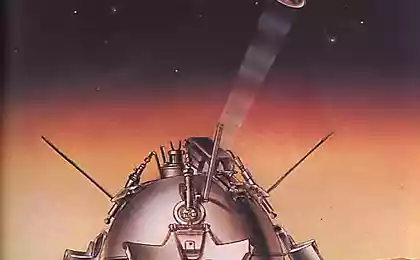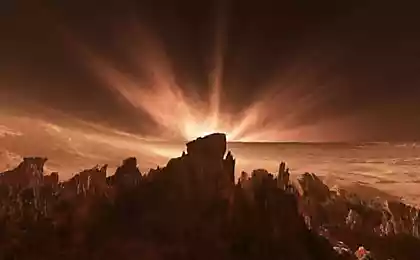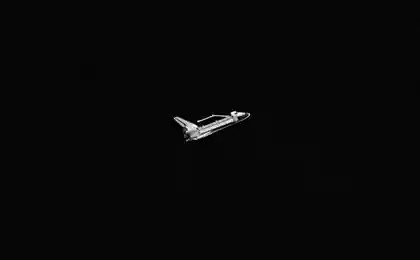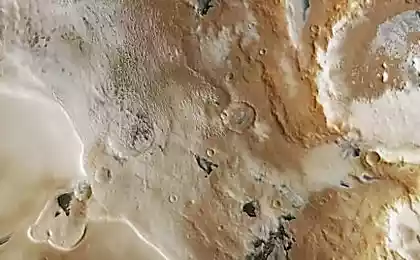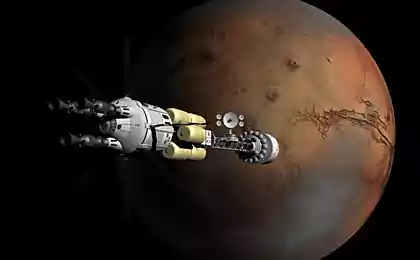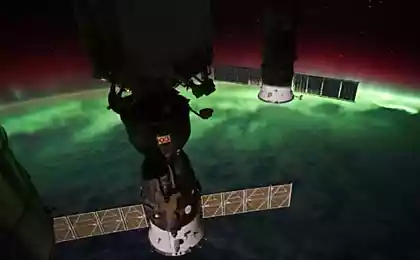1412
Analysis of "Martian": Mars, science, politics

I hope all already seen the movie, so do without spoilers. If you have not looked - better not to read, and the viewing experience may vary. Today analyze a film on the parts, and see what it fiction, but it looks like reality.
Mars
The first assumption is art and the first conflict with a real Mars - a sandstorm, which caused begins solitary adventure Mark Watney. Yes, it's a conscious fiction author Andy Weir - these storms on Mars can not be physically - the atmosphere is too sparse, so the wind can pick up a fine, dry dust. Sand wind may move only a few centimeters per month. Similarly, the wind on Mars is unable to threaten the established missile, at least as stocky as in the movie.

Good artists worked over the color of the sky. During the day, it is such - beige, passing in white close to the solar disc and black - to the zenith. Although the weather is calm, there is more light.

On Mars, the color of the sky depends primarily on the concentration of dust in the atmosphere. If windy off-season, the sky becomes almost all beige. If windless winter, the black sky descends close to the horizon.
51,361,016
In general, the Martian sky can be represented on the Earth during one of sandstorms arriving from the Sahara.

But in Martian dust storms sky color turns brown, as shown in the film some landscapes.
With sunset operators to repeat the mistakes that were made by NASA back in the 80s. Earthly experience tells us that the sunset red, and if we add to it a red dust, we get a rusty sky.

But this is a mistake. The atmosphere of Mars is not enough to scatter sunlight to the red part of the spectrum, so the sunsets turn blue - about as much as the Earth's atmosphere scatters light in the afternoon.

The area for the filming of "Martian" picked up a convincing - Mars looks like. Place on a neighboring planet is quite possible to find something similar. Erroneous, or rather misleading, the movie is that it supports the stereotype uniformity Martian landscape.

During his journey the hero overcome lava plain track catastrophic floods down into a giant crater. But the picture seems to be that he is constantly riding on the sand between the three weathered mountains (although in fact is the case).
Before the release of the film, NASA released satellite image of the area where the plot of the expedition landed Ares-3.

You can see what the landscape is like not even close to the one that we see in the film. Before us is just a relatively young lava plains, the sand is very small, old mountains with traces of severe erosion either. It would be interesting to look at the small mud volcanoes pimples that appear there when the lava laying layers of moist soil or ice. But overall, the terrain is quite boring for science, so to fly directly in this place it is not clear why, but more on that below.
The second major assumption is art, but rather a lack of knowledge of the author of the question - is the production of water. The author was so fascinated with engineering details that I forgot about the Martian conditions.

If you look at the map of the distribution of water in the surface soil of Mars, we see that in place of the events, the water is about 3% of the soil. It's quite a bit, but greater than zero, ie, for the extraction of water on Mars need not explosive experiments with toxic propellants, and a shovel, and a simple moonshine distiller. Moreover, according to satellite data from the Mars rover Curiosity should be 5%, and in some places he ran into layers of 6% and 10% water, so that Mark could get lucky.
The last thing in the Martian theme I would like to touch upon - is the soil. The film and the book here we implanted the same stereotype that and landscapes - as if Mars is the same. Astronauts needed a primer for potatoes, he walked out the door and dug.

In reality, the different layers of soil on Mars were formed in different physical conditions in different climatic periods and contain different chemical compounds. The surface layer is a witness to the last geological period when volcanic gases saturated soil sulfur and chlorine compounds evaporate which inevitably kill and the colonizer potatoes and heroic, almost on them shed water.
There on Mars and more fertile breed (at least less harmful), like a layer of clay, which discovered the rover Curiosity. There are both organic compounds and nitrogen dioxide, ie, components practically necessary for successful farming.

Moreover, the nitrogen content, think a hundred times greater than the rate of nitrogen fertilizer for the fields of the earth. So, before planting the potatoes would have to spend a lot of tests and experiments to determine the local deposits of potentially fertile soil, the necessary ratio component may create a mixture thereof, and only then start planting.
Another such moment suggest microbiologists: to become the ground soil, suitable for agriculture, its composition should be not only organic, but also the necessary bacterial culture. The required set of cultures includes dung of herbivores, but the "products" of human origin for this are not good.
Science
One blunder, appears in the film before a sandstorm when astronauts roam around the neighborhood and collect pebbles base. It seems to be all right, just as there were in the real landing on the moon. But on the Moon research was at an early stage, when any selected stone turned out to be a priceless gift to the whole earth science, and scientists do not fly there.
In contrast to the Moon 70, Mars is even now very well understood with the help of satellites and rovers. Scientific problems of people on Mars will be much more complicated functions of the rovers, which are already able to study colliding stones, and by the year 2020 and are planning to gather a collection.
We all remember that Mars is covered with craters? So the stones can bring bursts of dozens of kilometers, and pick up the debris without reference to the overlying rock - a meaningless exercise. Even rover Curiosity currently pays little attention to counter stones - he studies the occurrence of geological layers, their sequence, power and structure.

People need to do the same, and where it is much needed: on the walls of canyons, caves or in river valleys. Only the people can hold deep drilling to collect core samples, prepare them for delivery to Earth.


After these studies, Mark Watney would be much easier to find layers and with a high content of water in the soil, and low content of pesticides, but in the book and film about this word.
Few words to say about the places and landings. The points selected by the author, quite frankly, "from the bulldozer." Now, if desired, can be found areas of the Martian terrain, who are primarily interested scientists: published prospective landing sites and Curiosity rovers "exomars." None of the lists no Acidalia Planitia, no crater Schiaparelli. But in all the projects considered the option of landing in the valley of March ( Mawrth Vallis ).

On the map it is located between the book Ares-Ares-3 and 4. There's a very interesting sediment remaining as a result of the vigorous activity of water. There's layers can be found many interesting things. It is likely it will go to "exomars" or the next Mars rover NASA in 2020.

The phrase book and cine head NASA «We are a public organization, if the frame is removed, you must publish it within 24 hours" - is also fantastic. Really open and PR NASA - is the goodwill of the agency, and the realization that the better they will show their work to taxpayers, the more they will receive funding. Large mission, which attracted a lot of attention, they light activity, such as a rover Curiosity or probe Cassini all pictures are automatically uploaded to the open server at the time of arrival of the cosmos.
Other missions, such as Messenger or New Horizons more restrained the publication of materials. To find the source Messenger is necessary to work hard, and sources New Horizons spread with a delay of weeks or months, as a rule already after the publication of official press releases where posted photos prepared for publication.
All the data is ultimately discharged to PDS-archive , but with a semi-delay. This is to ensure that the scientists who work in the missions, had to analyze them, and to make discoveries. In contrast, European scientists as jealous and images, such as a comet explorer Rosetta some shots published only a year after their receipt.
policy
German in the crew of NASA - that's fine. The United States and the European Union almost one manned program for two. Right now they work together to build a manned space ship Orion, and probably will fly together.
The most painful for the domestic audience question: "Where is Russian?».
Some saw this as a deep anti-Russian propaganda plan. But it seems to me, dislike of Russian - Andy Weir is something personal. Throughout the book he referred to the Soviet and Russian space program a couple of times, and quite unreasonable arrivals.
The excuse of the author and filmmakers can say that whether Russian in their story, it would not have been such a profound drama shearing spare missiles to rescue an astronaut. Find "Union" with "Fregat" to throw a ton of corned beef on Mars Russia has always been able to. Indian and European missiles, by the way, the book is also ignored, as the existence of SpaceX .
Perhaps as an apology, or maybe just from the incompetence of the designer, the Russian "Soyuz" has got all the posters "Martian».

Very unrealistic phrase sounded in the movie of the Chinese officials "let scientists decide." In the book it is somehow explained by saying let them think they are ready to exchange the start of the solar observatory taikonaut flight to Mars. The film is, the phrase served as a gesture of generosity and respect for the officials to the scientific community.

Really, let the will of the scientific community, and it will close the manned program in general, for people in flights of 90% and 10% promote science. For the cost of a manned flight to Mars, the solar system can fill up observatories, probes and planetary rovers that will do science. Therefore, issues of manned space programs always be settled policy.
Today complete movie review, and tomorrow will continue the analysis of the most extensive technical side of the film.
Source: geektimes.ru/post/269718/






